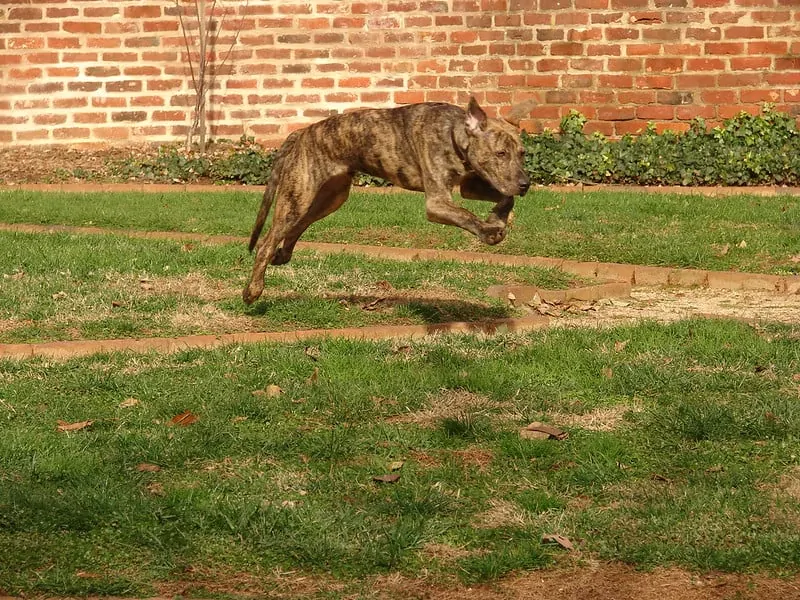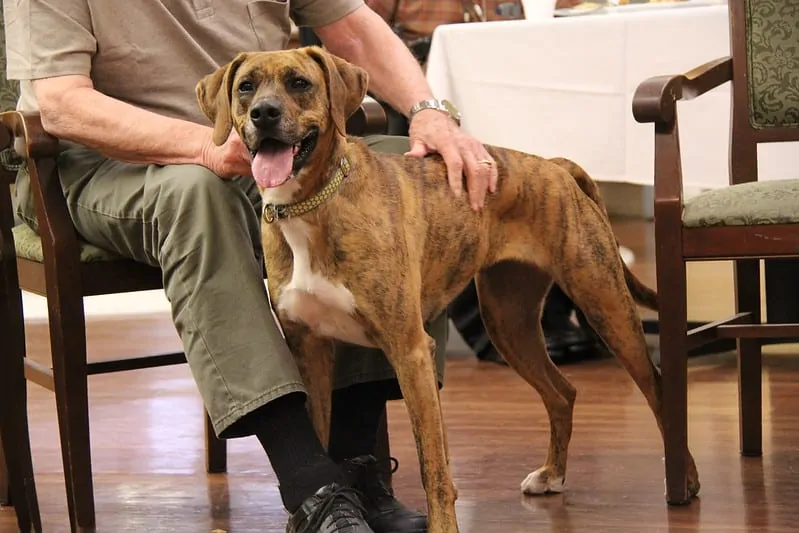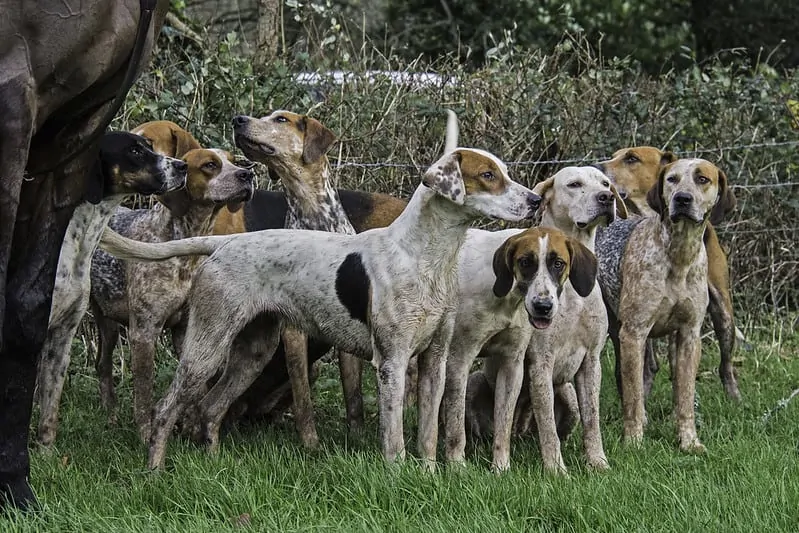When looking at the American scenthound breeds, you might assume they all share a similar history. But if you are including the Plott Hound in that assessment, you’d be wrong.
Keep reading to find out what makes this handsome striped hound so unique among treeing and trailing dogs and if one of these athletic and powerful hounds is right for your family.
Contents
General Characteristics of the Plott Hound
- Other names: Plott
- Height: 20 to 25 inches
- Weight: 40 to 60 pounds
- Lifespan: 12 to 14 years
- Origin: American South
- Colors: Any shade of brindle, with or without a black saddle
- Activity level: High
- Grooming needs: Low
- Best suited for: Hunters or active outdoorsy families
Like most scenthounds, the PH has warm soulful eyes and a rolling bay. But unlike most other American hound dogs, this breed descends from German hunting dogs, not the foxhound. “George’ by Michelle Minor / CC BY-NC-ND 2.0
The History of the Plott Hound
Of all the coonhound breeds that originated in the American South, the Plott Hound is the only one that is not descended from the Foxhound. In fact, the Plott’s forebearers weren’t English at all. Instead, they hailed from Germany and were largely made up of big-boned hunting breeds used to track and take down boar.
In the middle of the 18th century, Johannes “George” Plott emigrated to the United States from Germany. He brought with him a small pack of Hanover Hounds–large, stout scent dogs used in the home country for boar and bear hunting.
Determined to keep his hunting hounds pure of blood, Plott did not outcross his dogs. But when his son, Henry Plott, took control of the breeding program he did allow for some cross-breeding. Most notably, one sire was crossed with multiple “leopard-spotted” hounds from Georgia.
There is some evidence that Blevins and Cable hounds common to western North Carolina where Henry lived, were also introduced into the bloodlines.
Whatever their exact genetic makeup, the PH grew into a capable and celebrated hunting companion renowned for its ferocity, athleticism, and versatility. These dogs are able to track game, trail wounded animals, and tree smaller prey. They have been used to hunt large animals such as bears, big cats, and wolves, as well as smaller animals such as raccoons.
While many of today’s Plotts are kept as family companions, just as many, if not more, are still utilized as hunting hounds with their popularity growing in recent decades not just in America, but around the world.
<iframe width=”560″ height=”315″ src=”https://www.youtube.com/embed/Y693P3VZl6Q” frameborder=”0″ allow=”accelerometer; autoplay; encrypted-media; gyroscope; picture-in-picture” allowfullscreen></iframe>
Learn more about the unique history of this American breed in the video above.
The Temperament of the Plott Hound
The Plott is a hound through and through. Even more so than your typical coon dog, these canines are active and athletic and require vigorous exercise daily to keep them happy.
They enjoy being outdoors but have such an intense prey drive that they should not be allowed off-leash unless they are on the hunt. A large backyard secured with a tall fence is a must for keeping these pups content. They enjoy long walks, hikes, and make great jogging companions.
Beyond the basic need for activity, these high-drive dogs need to have their minds exercised. They are renowned for their intelligence and independent problem-solving skills. They are great candidates for many dog sports but especially excel at scent work, search and rescue, hunting competitions, and nose work trials.
Their athleticism and affinity for water also make them good candidates for dock diving competitions.
If your goal is to find a dog to accompany you on the weekend coon or boar hunt, there are few better choices. But if you are hoping for a companion animal, you may need to choose your Plott carefully.
The PH has a dominant personality and enjoys burning off energy with vigorous exercise and romps through nature where they can put their nose to the ground and their brain to work. “Fenris Leaping” by Matthew / CC BY-MC 2.0
Lines bred for bringing down large game tend to be quicker to aggress and more aloof around people they don’t know. While those bred for treeing may have a disposition better suited for the family life, though they will still need quite a bit of exercise.
No matter which type, you can expect the PH to be slightly standoffish with strangers, though most are quick to warm up. Those highly driven dogs, however, may be too focused on finding their next animal to chase to care much for socializing.
Like all hounds, these dogs come with an extra-large voice box capable of producing an impressive array of loud bays, barks, and howls. They are not well suited for apartment living or even close suburban neighborhoods.
In addition to their hunting abilities, these dogs have also been long-prized for their ability to protect the home and alert their owners to intruders. They were also historically used to herd livestock and help with various chores around the homestead.
Overall, the Plott is a happy, driven dog, with a need to get out into the great outdoors. They have a high prey drive which can conflict with traditional family life but are loyal and intelligent dogs perfect for the big game nut or avid hiker.
PHs tend to be gamey and driven largely by their instinct to track and chase. It is possible, though, to get a dog that is much more subdued. In either case, these dogs do enjoy the company of their humans and can make great companions. “Richmond Animal League” by Eli Christman / CC BY 2.0
Health Issues Common to the Plott Hound Breed
Despite a history that includes a start with a relatively small gene pool, the PH is a remarkably healthy breed with few genetic issues. Still, there are some health problems you should be aware of before bringing one of these striped beauties into your home.
Here are the most common health issues seen in Plotts.
- Hip dysplasia
- Ear infections
- Bloat
But, by far, the biggest risk to your PH if you are using them for hunting, is injuries sustained in the field.
These athletic animals can move quickly, especially on the trail of a large animal such as cougar or boar. Typically, they will track and hold the animal (by barking and lunging) until the hunter can get there to finish the task. While a pack of these dogs working together is usually capable of holding off even the largest of animals, injuries do occasionally happen.
Any owner interested in working these dogs for their traditional function should be prepared with a well-stocked dog first aid kit and a sling for bringing wounded animals back.
Whether you are looking for a hunting dog or companion, it is typically easy to find a healthy puppy once you have completed the difficult task of finding a breeder.
The AKC lists the PH as the 171st most popular of only 195 breeds. Your best bet for finding a reputable breeder is to visit the dog’s home state of North Carolina, though they have become more popular worldwide in the last few years.
This wiggly puppy will soon be an energetic and agile go-getter with a strong nose and a wall-shaking bark. Before you consider bringing home one of these active pups, consider how much time you will have to dedicate to them and if your yard and lifestyle are right for such a driven animal. “Angel in Grass” by James Emery / CC BY 2.0
This growing popularity does mean there are more and more Plotts and Plott mixes available through breed rescues, especially in the south. If you would prefer to adopt, try contacting your local hound rescue group to learn more.
Do Plott Hounds Do Well With Children and Other Pets?
Despite their high-drive and ferocity out in the mountains, the PH is typically a loyal and gentle family dog.
They tend to be tolerant of children and enjoy the company of older kids. There are even a number of stories from the early days of the breed that tell of dogs saving children from attacking bears or loose cattle.
While this instinct to protect and care for their family is hard-wired, how well a dog gets along with children will always depend on the amount of socialization they received with kids as a puppy. To increase the odds that your dog will remain a gentle and happy family companion it is paramount that you introduce them to kids of all ages in various situations before they reach adolescence.
Traditionally, the PH has been used to hunt in packs, especially against larger game. Like all hounds, they tend to get along well with other dogs. Though, the Plott is known to be a little feistier with other canines than your typical pack dog. This is especially true of the high-drive lines.
Like these staghounds, PHs are typically put on the hunt in packs, especially when in pursuit of large game like bears, boar, and cats. Of all the pack hunters, the PH is one of the most headstrong, however, and they may not always get along peacefully with other dogs. “Staghounds” by Mark Robinson / CC BY-NC 2.0
As far as other furry family members go, the high prey drive of the PH should always be considered before introducing them to smaller pets and those of a different species, including livestock.
Socializing Plott pups with a variety of animals in positive environments can help produce adults that are more willing to share their home with cats and other animals, but this should not be an expectation for the breed.
What to Consider Before Bringing Home a Plott Hound
Think you have what it takes to tame one of these active hound dogs? Here are a few more things to consider before bringing a PH into your home.
Activity Level
When it comes to tiring out a PH, a walk around the block isn’t going to do it. In fact, a walk around the mountain may not even be enough. These dogs need high-velocity exercise to truly wear them down. While jogging and hiking are better choices, you do have to include some mental stimulation in their daily routine as well.
Taking your pup out on a long line that will allow them to track scents and run for short bursts is a great idea if you don’t have access to large, open fenced areas. Dog sports and scent trials are also great options for tiring out this active hound.
Trainability
This dog’s intelligence and eagerness to please their handler should make training a breeze, but their drive and pin-pointed focus can often get in the way. After all, they would much rather be out back chasing squirrels than working on obedience skills for treats or praise. But with the right combination of motivation and energy, this breed is a great candidate for trick training.
With their long legs and lighter build, the PH tends to be more agile than other scenthounds. They are known for their speed and agility on the trail. “Burrito Serene” by final_end / CC BY-NC-ND 2.0
When it comes to hunting, these dogs are hardwired to do what they do best. Still, putting down a foundation of simple obedience skills such as sit, stay, and come when the dog is young is absolutely necessary.
Because these dogs were bred to trail, don’t expect to be able to teach one to walk well on a leash. Your time will be better spent investing in an effective no-pull harness that will help spare your shoulder.
Grooming
The short, sleek coat of the PH does not need much day-to-day care. The occasional brush, especially during the seasonal shed, will be plenty to keep them looking their best. A bath every once in a while is also necessary to keep your hound from smelling like a dog. It is important to check their ears frequently, as their long, pendulum ear flaps can trap debris and bacteria.
Your PH will also need frequent nail trims and dental attention.
Nutrition
Most Plotts will do well on any high-quality commercial or raw food. They are medium-sized dogs, so a general non-breed specific feed will work well for both adults and puppies. Plotts are lighter built than other scenthounds but are prone to weight gain, especially if they are not getting enough activity. Portion out meals carefully and adjust depending on the amount of exercise your dog is getting.
Cost
While these dogs are rare, a purebred puppy actually sells for a very reasonable price at around $300 to $500. This is well below the average puppy price and reflects this dog’s continuing use as a utility animal over that of a companion or show dog.
Overall, the PH is a healthy dog with relatively few needs other than a lot of room to roam and plenty of attention and exercise. You can expect owning one to cost, on average, less than your typical dog.
The PH and the Bloodhound share a common ancestor in the St. Hubert Hound. Despite the obvious differences in size, shape, and coloring, the two also share a similar ability to track cold game trails and an intense trailing drive. “Bloodhounds” by Mark Robinson / CC BY-NC 2.0
10 Fun Facts About the Plott Hound
Now that you know what it takes to own one of these high-drive tiger-striped dogs, here are some fun facts about the breed.
- In 2019, the AKC voted to change the name of the breed from simply “Plott” to “Plott Hound.”
- The St. Hubert Hound, similar to the modern Bloodhound, likely played a role in the development of the PH’s ancestors.
- The Plott is the state dog of North Carolina.
- These dogs have a slightly different sound than other scenthounds that can be distinguished by a ringing “chop” whether they are trailing an animal or have cornered or treed the game.
- Despite being a renowned breed in the south for more than two centuries, the PH did not receive official AKC status until 2006.
- They have a tendency to develop food and toy aggression and care should be taken to avoid these behaviors through positive association training.
- While pure brindle coloring is always preferred, a black saddle and/or white spots on the chest and toes are permissible.
- These lighter built hounds tend to be taller and have slightly shorter ears than your typical scenthound.
- Like Bloodhounds, they are known for their ability to trail wounded animals for miles even days after the fact.
- These agile dogs were built for rugged terrain and they enjoy climbing and scrambling as well as swimming.
Before You Go
Not sure you have the right lifestyle for one of these active hounds with a dominant personality? Here are a few more breeds to consider.
“Roxanne with Her Puppy Dog Eyes” by bullcitydogs / CC BY-NC 2.0

Sara Seitz has spent most of her life in the pet industry and has a bachelors in animal behavior from Colorado State University. Sara started working with dogs and cats as a high schooler at a rural boarding kennel. There she learned a lot about the bad and the ugly of the pet service industry. But not even the toughest day at that job would dissuade Sara from following her dream of working with animals.
In college, Sara got a job at a dog daycare and boarding facility in Fort Collins, Colorado. Her new career provided even more opportunities for learning about dog behavior than her classes did. As general manager of the daycare, Sara helped the company launch a new in-home pet sitting branch and trained to become a certified dog trainer. Between shifts taking care of peoples pets in-home and supervising dogs during playtime at the daycare, Sara organized and taught obedience classes.
Sara has always been passionate about bettering the lives of our canine companions. She soon found that advocating for and educating owners in the power of positive reinforcement training was one of the best ways to help dogs and their owners live happier lives.







